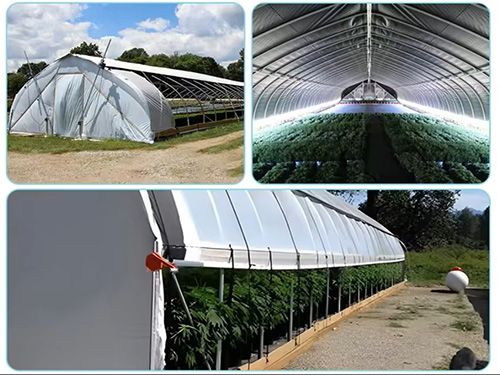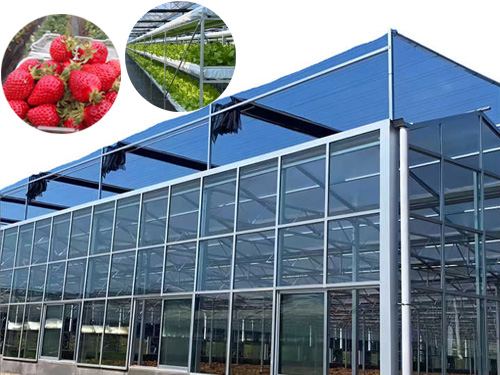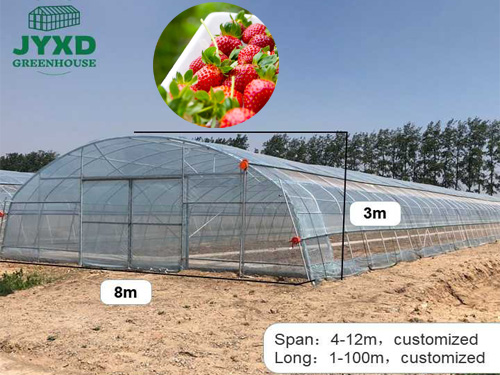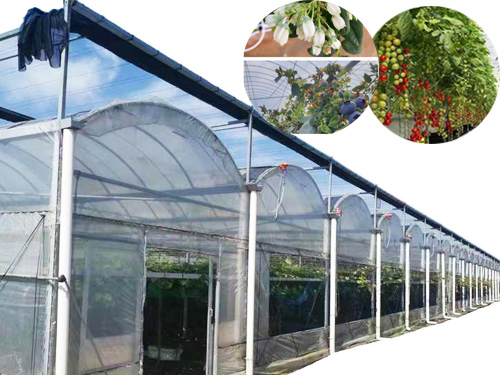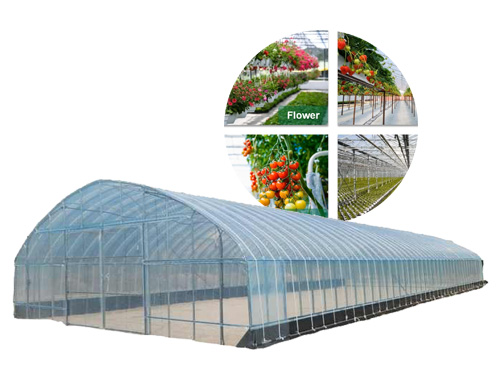NEWS DETAILS
NEWS INFORMATION
How to Prevent and Control Plant Diseases in Greenhouses
AUTHOR:jyxd-greenhouse DATE:2025-03-18 02:23:27 HITS:125
Greenhouses offer controlled environments that promote healthy plant growth by regulating temperature, humidity, and light. However, they also create conditions that can encourage the spread of plant diseases, especially if not managed properly. Plant diseases in greenhouses can quickly become widespread, affecting not just individual plants but entire crops. Effective prevention and control strategies are essential to ensure the health and productivity of your plants. In this article, we will explore the most common types of plant diseases in greenhouses, as well as proven methods for prevention and control to keep your greenhouse environment safe and productive.
1. Common Types of Plant Diseases in Greenhouses
Understanding the different types of plant diseases that commonly affect greenhouse crops is the first step in effectively managing them. There are two main categories of plant diseases in greenhouses: fungal diseases and bacterial diseases. Additionally, viral infections can also pose a threat to greenhouse plants.
Fungal Diseases
Fungal diseases are among the most common and destructive in greenhouses. They thrive in humid, warm environments, making greenhouses an ideal breeding ground. Common fungal diseases include:
• Powdery Mildew: A white, powdery coating on leaves and stems that affects plant growth and vigor.
• Botrytis (Gray Mold): A fungus that causes gray mold to grow on decaying plant tissue, spreading rapidly under humid conditions.
• Damping-Off: A soil-borne fungal disease that affects seedlings, causing them to wilt and die before they can fully mature.
• Downy Mildew: A fungal disease that causes yellowing of leaves and stunted growth.
Bacterial Diseases
Bacterial diseases, although less common than fungal diseases, can be equally destructive. These diseases spread quickly and often cause irreversible damage to plants. Common bacterial diseases in greenhouses include:
• Bacterial Wilt: Caused by the bacteria Ralstonia solanacearum, it results in wilting, yellowing, and death of affected plants.
• Bacterial Leaf Spot: Small, water-soaked lesions on leaves that can spread to other parts of the plant.
• Fire Blight: A bacterial infection that causes leaves, flowers, and branches to blacken and wilt, particularly in fruit-bearing plants like apples and pears.
Viral Diseases
Viral infections are harder to treat and are typically spread by insects, such as aphids. Common viral diseases include:
• Tomato Mosaic Virus: This virus causes discoloration and distortion in tomato plants, reducing yields.
• Cucumber Mosaic Virus: Affects a wide range of crops, causing stunted growth and yellowing of leaves.
2. Strategies for Preventing Plant Diseases in Greenhouses
Prevention is always more effective than dealing with an outbreak once it has occurred. Implementing robust preventive measures can significantly reduce the likelihood of plant diseases in your greenhouse.
2.1. Maintain Proper Hygiene
Good greenhouse hygiene is one of the most effective ways to prevent the spread of plant diseases. This includes:
• Regularly cleaning surfaces: Clean tables, shelves, and floors to remove any organic material where pathogens can survive. Use disinfectants approved for use in agricultural settings.
• Sterilizing tools and equipment: Tools, pots, and other equipment should be sanitized between uses. This helps prevent cross-contamination between plants.
• Proper disposal of infected plants: Remove and properly dispose of diseased plants to avoid spreading the infection to healthy crops. Do not compost diseased plants.
2.2. Control Humidity and Moisture
Excessive moisture and high humidity levels create an environment where fungal pathogens thrive. To minimize the risk of fungal diseases:
• Use dehumidifiers: Dehumidifiers help to maintain a consistent humidity level in the greenhouse, reducing moisture buildup that can encourage fungal growth.
• Improve drainage: Ensure proper drainage to prevent water from pooling around plant roots, which can encourage root rot and other fungal diseases.
• Watering practices: Water plants early in the day so that leaves dry by the time evening comes. Avoid overhead watering, as this can increase humidity and promote fungal infections.
2.3. Introduce Biological Control Agents
Using beneficial organisms to fight off pests and pathogens is an eco-friendly and effective way to manage plant diseases. Biological control agents include:
• Predatory insects: Introduce natural predators like ladybugs and predatory mites to control insect pests that can spread disease.
• Beneficial fungi: Certain fungi, such as Trichoderma, can outcompete harmful fungi and prevent them from infecting plants.
2.4. Rotate Crops and Use Resistant Varieties
Crop rotation helps to prevent the buildup of soil-borne pathogens that can target specific plants. By rotating the crops you grow, you reduce the risk of disease cycles that thrive in the same soil year after year. Additionally, selecting plant varieties that are resistant to common greenhouse diseases can significantly reduce the chance of an outbreak.
2.5. Regulate Temperature
Temperature regulation is key in managing plant diseases. Many pathogens thrive in high humidity and warm temperatures, so maintaining a consistent temperature range can prevent the proliferation of these organisms. Use thermostats, heaters, and fans to maintain a steady environment that discourages pathogen growth.
3. Effective Control Measures for Plant Diseases
Even with the best preventive measures in place, disease outbreaks can still occur. In these cases, prompt and effective control strategies are necessary to minimize damage.
3.1. Fungicides and Bactericides
When an outbreak occurs, fungicides and bactericides can be effective tools for controlling fungal and bacterial diseases. However, it’s important to:
• Choose the right product: Select fungicides and bactericides that are appropriate for the specific disease and safe for the plants you are growing.
• Follow application instructions: Apply the products according to manufacturer instructions and avoid overuse, which can lead to resistance in pathogens.
3.2. Use of Resistant Varieties and GMO Crops
Planting disease-resistant varieties is a proven method of preventing and controlling plant diseases. Many seed companies offer varieties of crops that are bred to resist common pathogens. Additionally, genetic modification (GMO) has made it possible to create crops with inherent resistance to specific diseases, providing a long-term solution.
3.3. Temperature and Humidity Adjustments
If a disease outbreak is detected, adjust temperature and humidity levels to slow the spread of the disease. Lowering humidity levels, increasing airflow, and reducing temperatures can inhibit the growth of fungal pathogens.
3.4. Quarantine Infected Plants
If you detect diseased plants, it’s crucial to isolate them from healthy crops immediately. Quarantining infected plants helps prevent the spread of pathogens to other parts of the greenhouse. Dispose of the infected plants properly to avoid re-contaminating your greenhouse.
4. Conclusion
Preventing and controlling plant diseases in greenhouses requires a proactive approach, including maintaining proper hygiene, regulating humidity, using biological controls, and selecting disease-resistant varieties. While disease outbreaks can still occur despite preventive measures, timely intervention with fungicides, bactericides, and temperature adjustments can help control the spread and minimize damage. By implementing these strategies, greenhouse operators can protect their crops, reduce losses, and maintain healthy, productive growing conditions. With consistent monitoring and careful management, you can create an environment where plants thrive and diseases are kept at bay.
For advice on effective disease prevention and control solutions, contact us today. Our team of experts can help you select the best tools and practices to keep your greenhouse healthy and productive.
Hebei Juyou Xinda Greenhouse Facilities Co.,Ltd.
Copyright © 2024-2025 https://www.jyxd-greenhouse.com. All Rights Reserved Hebei Juyou Xinda Greenhouse Facilities Co.,Ltd.Copyright





 Current Location:
Current Location:


